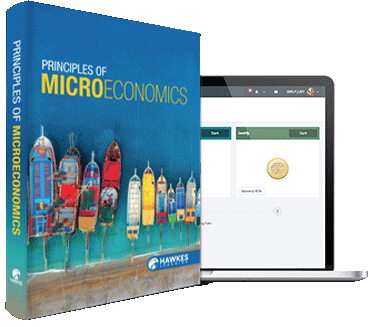
Principles of Microeconomics
Overview
Built in collaboration with contributing instructors across the country, this title introduces fundamental economics concepts through multimodal instruction, personalized practice, and automated assessments.
As students interact with current examples and real-world applications, they will recognize the role that economics plays in their personal lives and in the world around them.
Students also have access to basic mathematics remediation in the first chapter, which is designed to target math skill gaps in topics such as graphing, solving equations, and calculating area.
Bundle with the Guided Notebook, a supplemental print resource that walks students through the lesson content. It guides the note-taking process; asks students to identify key concepts; and includes extensive graphing practice, application-based exercise sets, and more.
Products
Formats: Software, Textbook, eBook, Guided Notebook
| Product | ISBN |
|---|---|
| Software + eBook + Guided Notebook | 978-1-64277-151-0 |
| Software + eBook + Textbook | 978-1-64277-234-0 |
| Software + eBook | 978-1-946158-95-6 |
Table of Contents
- Chapter 0: Math Review
- 0.1 Addition and Subtraction
- 0.2 Multiplication and Division
- 0.3 Order of Operations
- 0.4 Algebraic Expressions
- 0.5 Basics of Percent
- 0.6 Linear Equations
- 0.7 Graphing
- 0.8 Calculating Area
- Chapter Review
- Chapter 1: Welcome To Economics
- 1.1 What Is Economics, and Why Is It Important?
- 1.2 Economic Theories, Models, and Systems
- Chapter Review
- Chapter 2: Choice in a World Of Scarcity
- 2.1 How Individuals Make Choices Based on Their Budget Constraint
- 2.2 The Production Possibilities Frontier and Social Choices
- 2.3 Confronting Objections to the Economic Approach
- Chapter Review
- Chapter 3: Demand and Supply
- 3.1 Demand, Supply, and Equilibrium in Markets for Goods and Services
- 3.2 Shifts in Demand and Supply for Goods and Services
- 3.3 Changes in Equilibrium Price and Quantity: The Four-Step Process
- 3.4 Price Ceilings and Price Floors
- 3.5 Demand, Supply, and Efficiency
- Chapter Review
- Chapter 4: Labor and Financial Markets
- 4.1 Demand and Supply at Work in Labor Markets
- 4.2 Demand and Supply in Financial Markets
- 4.3 The Market System as an Efficient Mechanism for Information
- Chapter Review
- Chapter 5: Elasticity
- 5.1 Price Elasticity of Demand and Price Elasticity of Supply
- 5.2 Polar Cases of Elasticity and Constant Elasticity
- 5.3 Elasticity and Pricing
- 5.4 Elasticity in Areas Other Than Price
- Chapter Review
- Chapter 6: Consumer Choices
- 6.1 Consumption Choices
- 6.2 How Changes in Income and Prices Affect Consumption Choices
- 6.3 Behavioral Economics: An Alternative Framework for Consumer Choice
- Chapter Review
- Chapter 7: Production Costs And Industry Structure
- 7.1 Explicit and Implicit Costs, and Accounting and Economic Profit
- 7.2 Production in the Short Run
- 7.3 Costs in the Short Run
- 7.4 Production in the Long Run
- 7.5 Costs in the Long Run
- Chapter Review
- Chapter 8: Perfect Competition
- 8.1 Perfect Competition and Why It Matters
- 8.2 How Perfectly Competitive Firms Make Output Decisions
- 8.3 Entry and Exit Decisions in the Long Run
- 8.4 Efficiency in Perfectly Competitive Markets
- Chapter Review
- Chapter 9: Monopoly
- 9.1 How Monopolies Form: Barriers to Entry
- 9.2 How a Profit-Maximizing Monopoly Chooses Output and Price
- Chapter Review
- Chapter 10: Monopolistic Competition and Oligopoly
- 10.1 Monopolistic Competition
- 10.2 Oligopoly
- Chapter Review
- Chapter 11: Monopoly and Antitrust Policy
- 11.1 Corporate Mergers
- 11.2 Regulating Anticompetitive Behavior
- 11.3 Regulating Natural Monopolies
- 11.4 The Great Deregulation Experiment
- Chapter Review
- Chapter 12: Environmental Protection and Negative Externalities
- 12.1 The Economics of Pollution
- 12.2 Policies to Reduce Pollution
- 12.3 The Benefits and Costs of U.S. Environmental Laws
- 12.4 International Environmental Issues
- 12.5 The Tradeoff between Economic Output and Environmental Protection
- Chapter Review
- Chapter 13: Positive Externalities and Public Goods
- 13.1 Why the Private Sector Underinvests in Innovation
- 13.2 How Governments Can Encourage Innovation
- 13.3 Public Goods
- Chapter Review
- Chapter 14: Labor Markets And Income
- 14.1 The Theory of Labor Markets
- 14.2 Wages and Employment in an Imperfectly Competitive Labor Market
- 14.3 Market Power on the Supply Side of Labor Markets
- 14.4 Employment Discrimination
- 14.5 Immigration
- Chapter Review
- Chapter 15: Poverty and Economic Inequality
- 15.1 Drawing the Poverty Line
- 15.2 The Poverty Trap
- 15.3 The Safety Net
- 15.4 Income Inequality: Measurement and Causes
- 15.5 Government Policies to Reduce Income Inequality
- Chapter Review
- Chapter 16: Information Risk and Insurance
- 16.1 The Problem of Imperfect Information and Asymmetric Information
- 16.2 Insurance and Imperfect Information
- Chapter Review
- Chapter 17: Financial Markets
- 17.1 How Businesses Raise Financial Capital
- 17.2 How Households Supply Financial Capital
- 17.3 How to Accumulate Personal Wealth
- Chapter Review
- Chapter 18: Public Economy
- 18.1 Voter Participation and Costs of Elections
- 18.2 Special Interest Politics
- 18.3 Flaws in the Democratic System of Government
- Chapter Review
- Chapter 19: International Trade
- 19.1 Absolute and Comparative Advantage
- 19.2 What Happens When a Country Has an Absolute Advantage in All Goods
- 19.3 Intra-industry Trade between Similar Economies
- 19.4 The Benefits of Reducing Barriers to International Trade
- Chapter Review
- Chapter 20: Globalization and Protectionism
- 20.1 Protectionism: An Indirect Subsidy from Consumers to Producers
- 20.2 International Trade and its Effects on Jobs, Wages, and Working Conditions
- 20.3 Arguments in Support of Restricting Imports
- 20.4 Trade Policy
- Chapter Review
